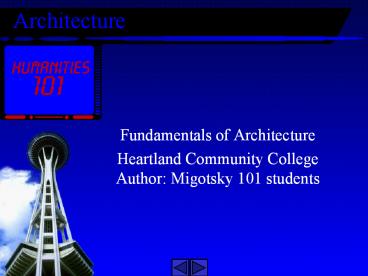Architecture PowerPoint PPT Presentation
Title: Architecture
1
Architecture
- Fundamentals of Architecture
- Heartland Community CollegeAuthor Migotsky 101
students
2
Styles of Architecture
- Egyptian
- Pre-Columbian
- Byzantine
- Islamic
- Gothic
- Cast-Iron
- Tibetan
- Georgian
- Modern
3
Egyptian Architecture
- Prior to 3000 BCE (before common era)
- Abundant clay and scarce wood led to early
development of ceramic art and brickwork
4
Pre-Columbian Architecture
- 300 BCE 300 ACE (after common era)
- Aztec and Mayan
- Mayan culture of Central America developed
elaborate monuments, palaces, and pyramids
5
Byzantine Architecture
- 330 ACE
- Byzantine Architecture is based on a legacy of
Roman technical achievements - A mixed style, composed of Greco-Roman and Asian
elements which, in earlier centuries, cannot be
clearly separated
6
Islamic Architecture
- 7th Century ACE
- Islamic Architecture is a synthesis r of styles,
with decoration on the surface as the most
important factor in every work. - Interlaced lines and brilliant colors
characterize the style
7
Gothic Architecture
- 12th Century ACE
- The Gothic Style was the dominant structural and
aesthetic mode in Europe for 400 years. - It emphasized the religious mania and the logical
formalism that were the essence of the medieval
period
8
Cast-Iron Architecture
- After 1800s ACE
- Used mainly as an alternative to masonry with
the introduction of wrought-iron beams at
mid-century, an efficient, prefabricated method
of skeletal construction was possible
9
Tibetan Architecture
- 15th Century ACE
- Tibetan architecture was derived from Indian
prototypes and was composed of one or more square
bases, a square balcony, a bulbous dome, and a
mast upholding umbrellas, surmounted by a finial - Famed for its enormous monastery-cities, which
housed thousands of monks.
10
Georgian Architecture
- 1714-1830 ACE
- In the 1st half of 18th century, there was a
countercurrent of Baroque architecture - The 2nd half of 18th century encouraged
architects in Italy and Greece to draw freely,
while incorporating classical elements .
11
Modern Architecture
- Post World-War I
- This styles mainly developed in Western countries
after the first world war. - Based on the use of modern materials
- Based on the principles of functionalist planning
and the rejection of historical ornamentation
12
Four Necessities of Architecture
- Technical Requirements
- Functional Requirements
- Spatial Requirements
- Revelatory Requirements
13
Technical Requirements
- It is important that the architect know the
limits and capabilities of the materials used, so
the structure will stand and withstand the test
of time and the environment. - Example Houses in the midwest should be designed
with tornado season in mind, roofs are peaked
in preparation for heavy snow
14
Functional Requirements
- Architects must be aware of the functional
aspects of their creations. - ExampleSchools are designed to hold large
numbers of people schoolrooms are usually
designed to direct all eyes forward, toward the
instructor
15
Spatial Requirements
- It is imperative that the architect take spatial
surroundings into consideration when creating
building plans. - Examples Zoning laws and safety must be
considered skyscrapers should not be built near
airport runways (for safety), and airports
should not be built near elementary schools (so
children arent constantly distracted)
16
Revelatory Requirements
- How the architect creates the form for a building
to reveal its function. - Examples Emergency facilities, such as
hospitals, should be immediately recognizable.
Most stores want to be recognizable to draw
business, and many Christian and Orthodox
churches are shaped like crosses, with a transept
and nave.
17
The Space That Defines Architecture
- Earth-Rooted
- Sky-Oriented
- Earth-Resting
- Earth-Dominating
18
Earth-Rooted Architecture
- Earth-rooted buildings emphasize the earth and
natural surroundings. - An example would be Falling Water, by Frank
Lloyd Wright (page 153).
19
Sky-Oriented Architecture
- Sky-oriented (or sky-reaching) architecture
emphasizes the sky as part of its space, rather
than as just a backdrop. - Many churches are examples of sky-oriented
architecture the steeples direct the eye
heavenward.
20
Earth-Resting Architecture
- Earth-resting architecture accents neither the
earth nor the sky, using the earth merely as a
platform with the sky as a background. - Most modern subdivisions are full of
earth-resting architecture.
21
Earth-Dominating Architecture
- Earth-dominating architecture does not attempt to
blend harmoniously with its surroundings, but
instead looms over the landscape. - Earth-dominating architecture is often meant to
portray a feeling of power, or intended to
command attention. - Many palaces are earth-dominating architecture.
22
Urban Planning
- A great deal of thought must go into urban
planning - Urban planning must allow for residential,
commercial, and industrial zones. - Examples Housing should not be located next to
waste facilities (although this happens) prisons
and bars must be located a specific distance from
schools and churches.
23
Conclusion
- There are a wide variety of historical
architectural styles - There are four necessities that every architect
must take into consideration - There are 4 individual types of architectural
orientation - Thoughtful urban planning is crucial to the
success and livability of a city
24
The End

